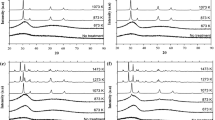Abstract
Crystalline zirconia has previously been formed by desiccation and pyrolysis of a pH 3.4 zirconium acetate precursor solution. In this study, amorphous gels were formed by desiccation of zirconium acetate precursor solutions at pH 0.9 to 3.4 obtained by adding hydrochloric acid and at pH 8.0 by adding ammonium hydroxide to the available pH 3.4 precursor solution. The concentrations of the uncomplexed zirconium ion and the 1 : 1 and 1 : 2 zirconium acetate complexes varied with pH. Decomposition of the amorphous gel and its structure evolution to form crystalline zirconia by pyrolysis were studied. Several decomposition and structure transition temperatures occurring in the pyrolysis and the polymorph distribution in the pyrolysis products were dependent on the pH of the precursor solution. These variations of structure evolution with pH were also related to the relative concentrations of specific zirconium complexes in the precursor solutions. Removal of carbon by pyrolysis was improved by adding hydrochloric acid or ammonium hydroxide to the pH 3.4 precursor solution.
Similar content being viewed by others
References
A.C. Geiculescu, J.H. Rack, B.L. Sullivan, and H.G. Spencer,Mater. Manuf. Proc. 14(4), 489 (1999).
A.C. Geiculescu and H.G. Spencer, J. Sol-gel Sci. Technol. 14, 257 (1999).
B.H. Davis,J. Am. Ceram. Soc. 67, C168 (1984).
L. Grahl-Madsen, J. Engell,and R.E. Riman, in Ceramic Powder Science III, edited by G.L. Messing, S. Harano, and H. Hauser (The American Ceramic Society, 1990), p. 33.
M. Henry, J.P. Jolivet, and J. Livage, in Ultrastructure Processing of AdvancedMaterials, edited by D.R. Uhlmann and D.R. Ulrich (Wiley, NY, 1992), p. 23.
W.B. Blumenthal, The Chemical Behavior of Zirconium (D.Van NostrandCo., 1958).
Ts.B. Konunova, M.S. Popov, and C. Kuang, Russ. J. Inorg.Chem. 14, 1084 (1969).
S. Hannone, F. Bertin, and J. Bouix, Bull.Soc. Chem. Fr. 131, 262 (1994).
H.P. Klug and L.E. Alexander, X-ray Diffraction Procedures (Wiley, NY, 1974).
R. Srinivasan, C.R. Hubbard, O.B. Cavin, and B.H. Davis, Chem. Mater. 5, 27 (1993).
A. Guinier, X-ray Diffraction in Crystals, Imperfect Crystals, and AmorphousBodies (Freeman, San Francisco, 1963), pp. 72–74.
K.K. Li, AStudy of PLZT Ferroelectric Thin Films Chemically Derived from Acetate Precursors, Ph.D. Dissertation, Clemson University, August 1993.
C.F. Baes, Jr. and R.E. Mesmer, The Hydrolysis of Cations (Wiley, NY, 1976), p. 155.
Author information
Authors and Affiliations
Rights and permissions
About this article
Cite this article
Geiculescu, A.C., Spencer, H.G. Thermal Decomposition and Crystallization of Aqueous Sol-Gel Derived Zirconium Acetate Gels: Effects of the Precursor Solution pH. Journal of Sol-Gel Science and Technology 16, 243–256 (1999). https://doi.org/10.1023/A:1008769204022
Issue Date:
DOI: https://doi.org/10.1023/A:1008769204022




